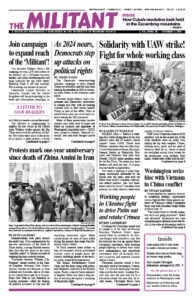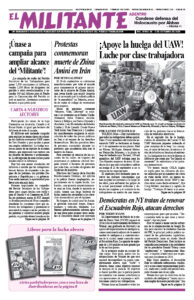Black lung, a devastating and often fatal disease caused by prolonged exposure to dust that scars lung tissue, has been on the rise among coal miners over the past two decades, as the bosses’ drive for profits comes at the expense of miners’ health conditions and lives. A big cause of this is the huge amounts of silica dust generated by digging through layers of sandstone to gain access to seams of coal.
Silica dust is 20 times more toxic than coal dust and causes severe forms of black lung after just a few years of exposure. Silica dust particles are so fine that respirators can fail to capture them and they get imbedded in miners’ lungs.
About one in five miners in the Central Appalachia coalfields of West Virginia, Kentucky and Virginia have black lung, the National Institute for Occupational Safety and Health reports. Miners and their union — the United Mine Workers of America — virtually eliminated black lung in the 1970s. Some 40,000 miners in West Virginia walked out of the mines in 1969, in a wildcat strike backed by the newly formed Black Lung Association. They forced the state legislature to pass a bill ordering coal bosses to pay compensation for black lung. Clinics were set up all over Appalachia.
The action inspired thousands of miners to rise up and take back their union, overthrowing the corrupt Tony Boyle regime. The union then fought to establish union safety committees in the mines, gaining the power to shut down production to enforce safe working conditions. Incidents of black lung declined more than 90% from the 1970s to mid-1990s.
Since then, part of a long retreat of the labor movement that is now at an end, coal bosses have been able to greatly increase the number of nonunion mines. There they run production with fewer miners working longer hours with greater exposure to the dust. And black lung has had a resurgence.
Under pressure from the union, the federal Mine Safety and Health Administration proposed a new rule this summer to cut the amount of silica dust that miners can be exposed to in an eight-hour shift by half — from 100 to 50 micrograms per cubic meter. As far back as 1974, on the heels of the big struggles waged by union miners in the coalfields, the change had been recommended by the Centers for Disease Control and Prevention.
“At long last, there is a proposed rule to limit the level of silica dust in mines,” said United Mine Workers President Cecil Roberts in a statement issued June 30. “Workers in other industries have long been protected from excessive exposure to silica dust, but miners were not, even though they work in an environment where silica dust is encountered daily.”
In a public hearing in Beaver, West Virginia, Aug. 10, miners discussed the proposed rule and their experiences being asked by company officials to help falsify samples to evade penalties.
“I’ve got 30 years of experience. I know the tricks and how they operate,” miner Terry Lilly testified at the hearing. He has black lung, with just 40% lung capacity. “If we can stop this, we can save some lives.”
At a black lung testing center in Oak Hill, West Virginia, at the end of August, Kevin Weikle, 34, found out he has already developed reduced lung capacity from progressive massive fibrosis, an aggressive form of black lung that affects younger miners. “It never crossed my mind that I’d be like this at 34,” he told the hearing.
Regulations by themselves accomplish little. It will take a renewed fight by the miners and their union, backed by active solidarity from the labor movement, to enforce the proposed new lower silica dust levels, and to reimpose union-run safety committees with the power to shut production.

